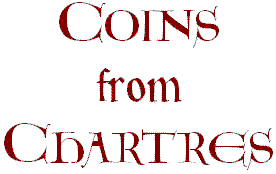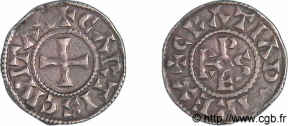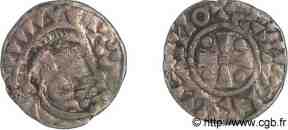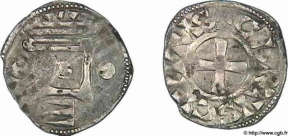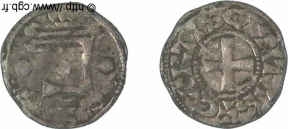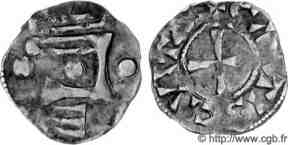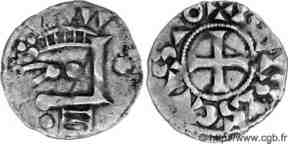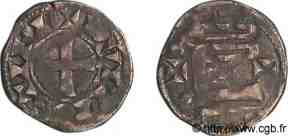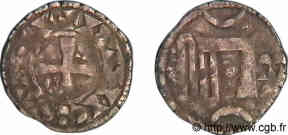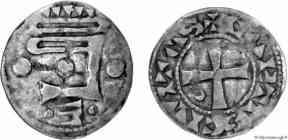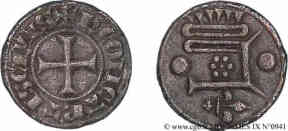[N.b. Before using this page,
please read this Caveat and
this Copyright statement.]
|
Coins were minted at Chartres
from pre-Roman and Roman(?) times. Then there appears to have been
an hiatus (I've been able to find no Frankish or Merovingian examples),
until the first half of the 10th century when the Robertian king,
Radulf (Raoul) seems to have had a mint in operation there, turning
out quite competent coins of an essentially
Carolingian character. Several surviving 13-14th
century pilgrims' badges from
Chartres have what appears to be a representation of a Chartrain coin
on them, recognizable by the peculiar and unique feature in the form
of an "anépigraphe" (as the French numismatists term
it) image which is quite difficult to decipher and even more difficult
to explain. |
|
Please
note that all of the coin images on this page (and those linked to it)
are from one of the best numismatic sale and (reference) sites on all
of the WWW, that of the Compagnie Generale de Bourse,
http://www.cgb.fr/index.html, which holds the copyright to them. |
|
(Click on image for a larger version) OBVERSE: "+ CRATIA D-I
REX", ("KING, BY THE GRACE OF GOD"; the legend beginning
at 9 o'clock). Around a Carolingian-type monogram of Radulf. Ref.: Lot VIII/1069. Dia.: 19.5 mm.;
Wt.: 1.40g. |
Silver Denier of King Radulf (923-936), from Chartres, c. 930-940 The monogram of
the obverse was inspired by that of Charles II, "the Bald," and Pierre
Crinon has shown that this type of monogram was used by Radulf on coins
from the mints of Aschères, Beaugency, Chartres, Châteaudun, Château-Landon,
Dreux, Étampes and Orléans (P. Crinon, BSFN, April, 1993, pp. 539-543).
These examples were rarely seen in the literature before the discovery
of the so-called "Loiret" treasure, from which this one may have come.
|
|
(Click
on image for a larger version) OBVERSE: A
prototype of a "Bléso-Chartraine" head: A profile head, facing right,
somewhat degenerated (though still readable as a head), with a small
cross before the face, a small cross and a group of four besants below(?),
and with seven small triangles forming the hair. |
Anonymous Silver Denier from the Lordship of Saint-Aignan (Berry, circa 1030) Saint-Aignan belonged
to Theobald "le Tricheur" in the early 10th century, but seems to have
been freed from Bléso-Chartraine control in the early 11th century,
during the term of the Counts of Chartres and Blois Theobald I (995-1004)
or Odo II (1004-1037). |
|
(Click
on image for a larger version) OBVERSE: A
head of the "Bléso-Chartraine" type, facing right, the mouth made by
three triangular bars, with a globe before the nose and a globe on the
left, under the crown. |
Silver Deniers of Count
Odo I, from Chartres, Legros thought
that this type of denier belonged to the time of Count Theobald II (996-1004);
however, similar examples have been found in various treasures: from
Troyes (buried at the beginning of the 11th c., yielding a single example);
from Saint-Hilaire (Essonne, buried between 1040 and 1060, with nine
examples); and from Vernou (Vernon, Loir-et-Cher, buried between 1060
and 1108, also with nine examples). An attribution to Count Odo I therefore
seems preferable. |
|
(Click
on image to see a larger version.) OBVERSE: Head
of the "Bléso-Chartraine" type, facing right, the mouth made of three
triangular bars, a besant before the nose, another on the left, under
the crown. |
Silver Denier of Odo II, Count of Chartres (1004-1037), c. 1030 Daniel Legros believed
this type to have been from the era of Theobald II (996-1004), but examples
have since been found in several treasures: a single example from that
of Troyes, buried at the beginning of the 11th c.; nine from that of
Saint-Hilaire (Essonne), buried between 1040 and 1060; nine also from
Vernou (Vernon in the Loir-et-Cher), buried between 1060 and 1108. Thus,
an attribution to Odo I seems preferable. |
|
(Click
on the image for a larger version.) OBVERSE: Head
of the "Bléso-Chartraine" type, facing right, made of three bars and
a besant, with a besant before the nose. |
Silver Denier of Theobald
III, Count of Blois, This type of coin
has been found in the treasures of Vernou (Vernon), buried between 1060
and 1108, and of Beaugency, buried a century later, circa 1270. |
|
(Click
on image for a larger version) OBVERSE: A
"Bléso-Chartraine" head, facing left, between two small crosses, the
eye formed by a besant, with a sort of "spear point" below. |
"Bléso-Chartraine"
Silver Denier from Châteaudun Daniel Legros (p.
392) believed that this particular type of coin |
|
(Click
on image for a larger version) OBVERSE: A
"Bléso-Chartraine" head, facing right, between two opposing crescents,
the eye formed by a besant, the chin by an epsilon in reverse; the hair
is indicated by five small inverted triangles. |
"Bléso-Chartrain" Silver
Denier from Châteaudun, from the time of Counts Theobald V and Louis Sixteen
deniers of this type were found in the treasure of Alençon (Orne, discovered
in 1840, containing 1,150 coins of which 328 have been identified, buried
circa 1213/5). |
|
(Click
on image for a larger version) OBVERSE: Head
of the "Bléso-Chartraine" type, facing right, the mouth made of three
triangular bars between two small globes, with a globe before the nose.
|
[N.b. My source was even more incomprehensible, self-contradictory and, perhaps, historically inaccurate than usual on this one:] Anonymous Silver Chartrain
Denier from the 13th Century, A denier type found
at the end of the 12th or beginning of the 13th c. which type D. Legros
attributed to Countess Isabelle (1218-1249). Similar
examples have been found in the treasures of Beaugency (Loiret, with
more than 600 pieces discovered in 1844, buried around 1270/1). |
|
(Click
on image for a larger version) OBVERSE: Legend:
"+ K- COM- CARTIS CIVIS"
("Charles, Count [of the] City of
Chartres"), around an equilateral
cross in the center. |
Large, Thick Denier of Count Charles de Valois (1270-1325), before 1319 This is an example
of the second of three known types of deniers struck for Charles de
Valois, Count of Chartres at Chartres. The first is slightly smaller
in diameter (19 mm) (Caron, n° 112, pl. V, n° 15, Legros n° 919); the
two others a bit larger (c. 25mm) and are said to be unique. This example
is, apparently, only the second one of the type known, the first having
been published first in the Revue Numismatique in 1846. Charles de Valois
(1270-1325) was the son of Philip III "le Hardi" and Isabelle of Aragon,
was the younger brother of Philip IV and father of Philip VI de Valois
(1293-1350). He married, first, Margaret of Anjou (+1299), the daughter
of Charles II of Naples; then Catherine de Courtenay (+1307), daughter
of Philip, titular emperor of Constantinople; and finally Mathilda of
Saint-Pol (+1358). |
|
[Caveat:
This page is the ad hoc result of an informal inquiry into the
nature of various pilgrims'
badges from Chartres which led, because of some of the images found
on the latter, to some curiosity about chartrain coinage. |
This Page is Definitely
